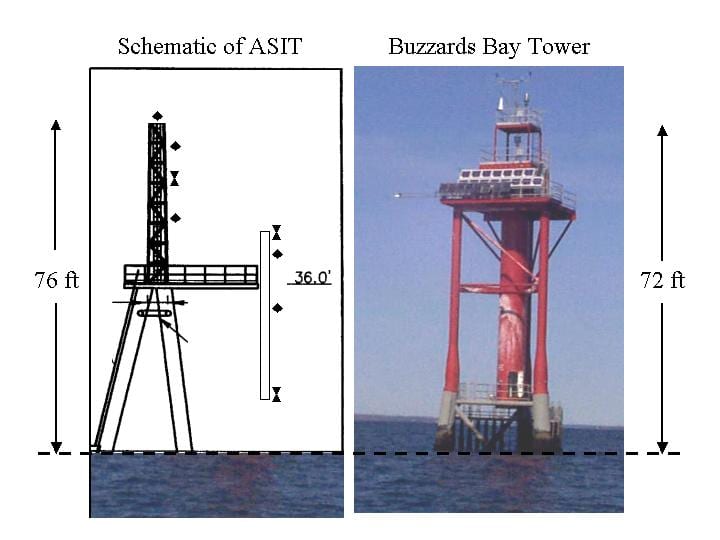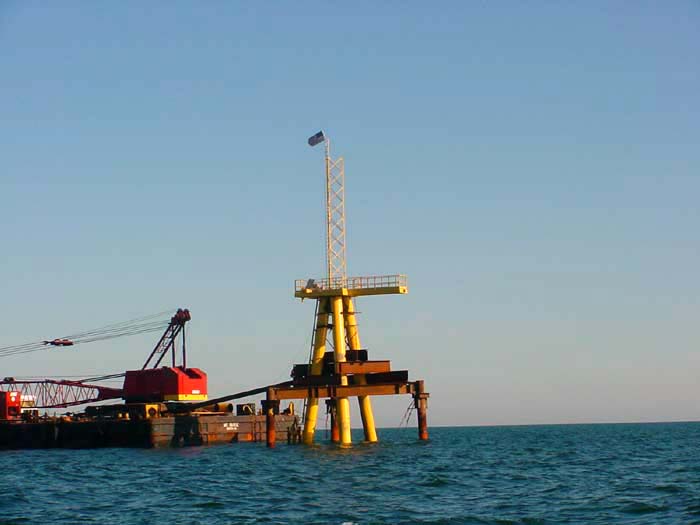Offshore Air-Sea Interaction Tower Expands Research Capabilities of the Martha’s Vineyard Coastal Observatory
September 9, 2002
Scientists at the Woods Hole Oceanographic Institution (WHOI) and their colleagues will gain critical environmental information from the Air-Sea Interaction Tower (ASIT) being built off the south shore of Martha’s Vineyard. Construction of the tripod-shaped tower began in August and is expected to be completed in late September. The tower will be linked to the Institution’s Martha’s Vineyard Coastal Observatory (MVCO), which was built and installed several years ago off South Beach near the Katama Airfield.
Sensors on ASIT will measure a variety of atmospheric and ocean conditions such as air temperature, humidity, solar radiation and carbon dioxide, as well as water temperature, salinity or salt content, wave height and direction, and current speed and direction. It will be located two miles due south of Edgartown Great Pond in 50 feet of water. It will extend 76 feet into the marine atmosphere and will be roughly the same height as the Buzzard’s Bay Tower located west of Cuttyhunk.
Funding for the ASIT was provided by the Office of Naval Research as part of the $8 million Coupled Boundary Layers and Air-Sea Transfer (CBLAST) program. The CBLAST main experiment will take place in the summer of 2003 using the ASIT, buoys, moorings, aircraft, and research vessels. The main objective of the program is to improve understanding of ocean-atmosphere interactions in low to moderate winds and to improve marine weather forecasts and ocean circulation models.
“This tower will be connected by underwater cable to the Martha’s Vineyard Coastal Observatory, which is already giving us important data about coastal circulation and waves, air-sea interaction in storms, and sediment transport,” said Associate Scientist James Edson of the Institution’s Applied Ocean Physics and Engineering Department, who serves as project engineer. “We will have an opportunity to learn an enormous amount about how the ocean and atmosphere interact under all conditions, including what factors affect the exchange of energy between the ocean and atmosphere, how readily carbon dioxide is exchanged, which is important to global warming studies, and how currents and waves affect bottom sediments.”
Edson says the tower is substantially less bulky than the Buzzards Bay Tower to minimize wind flow distortion by the structure and improve the quality of measurements. While the CBLAST experiment will be completed in two years, the ASIT is designed to survive the extreme conditions encountered offshore for at least 10 years. It is currently permitted to operate for the next five years and its continued operations will be evaluated at that time.
The ASIT is being constructed by RDA Construction Corp. of South Boston, MA. Power and data transmission capabilities are supplied through an underwater cable directly linked to the Martha’s Vineyard Coastal Observatory (MVCO). Data from the ASIT will be integrated with the MVCO data and made directly available to all users and to the general public via the MVCO web site at http://www.whoi.edu/mvco. The data will include wind speed and direction, air and sea temperature, wave height and direction, and currents at the offshore site.
“When finished, the ASIT will be a one-of-a kind platform for studying coastal processes in the Atlantic Ocean.” Edson says. “We expect it to be used by researchers, educators, and students from around the world during its lifetime.”


